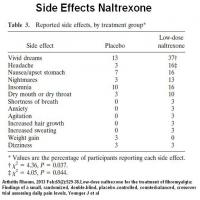Naltrexone has a number of known side effects. Patients should ask their doctors whether they can take the medication. Patients should also seek advice from their doctor if they are experiencing any side effects.
Naltrexone was approved by The Food & Drug Administration (FDA) in 1994 for the treatment of addictions, particularly for alcohol and opioids.

In 1963 naltrexone was developed to treat addiction. It is mainly used on opioids such as heroin, morphine, and oxycodone. More recently, it has been used to treat alcohol abuse.
It is considered a safe and proven medication. But like all medications, naltrexone does have a number of reported side effects. According to the Substance Abuse and Mental Health Services Administration (SAMHSA) the most serious ones are:
Fatigue
Vomiting
Diarrhea
Extreme stomach pain
Naltrexone is usually taken orally, in pill form. If naltrexone is being injected, redness or pain around the injection area is a danger sign. Other side effects: dark-colored urine, light-colored bowel movements, and yellow eyes or skin -- the latter can mean serious liver problems. The patient should see their doctor if any of these occur.
There are also less serious side effects: headache, nervousness, trouble sleeping, and joint pain. For headache or joint pain, patients can use over-the-counter pain medication. For nervousness or anxiety, patients can try exercise, a hot bath, or meditation unless symptoms persist.
For trouble sleeping, patients can try taking naltrexone in the morning. Other remedies include avoiding naps and going to bed at the same time each night. Exercise can help, and also, avoiding caffeine after lunch.
The Mayo Clinic notes other side effects as “rare”: blurred vision or eye pain, chest pain, confusion, difficulty urinating, fever, hallucinations, itching, depression or mood changes, ringing in the ears, shortness of breath, and swelling of the face, lower legs, or feet. The Clinic calls other symptoms “less common.” These include chills, constipation, cough, hoarseness, runny or stuffy nose, sinus problems, sneezing, sore throat, dizziness, fast or pounding heartbeat, increased thirst, irritability, loss of appetite, and sexual problems in males.
According to SAMHSA, there is a possibility of developing tolerance and dependence to naltrexone. However, when taken as prescribed, naltrexone dependence is most unlikely for most patients.
Patients should discuss all medications used. Dr. John E. Mendelson is co-founder of DxRx Medical in San Francisco, a company that uses naltrexone as part of its treatment program. He notes that the side effects of the drug are minor for most people. “Naltrexone can produce nausea and fatigue, but these side effects are most pronounced in the first few days of treatment.”
In conclusion, naltrexone has many benefits for those addicted to heroin, morphine, oxycodone, alcohol use disorder and other drugs. But prospective patients must evaluate the known side effects, and what to do if they occur. In most cases these will not be serious. But in cases where there are serious side effects a doctor must be consulted.
Get Smart about Recovery™
